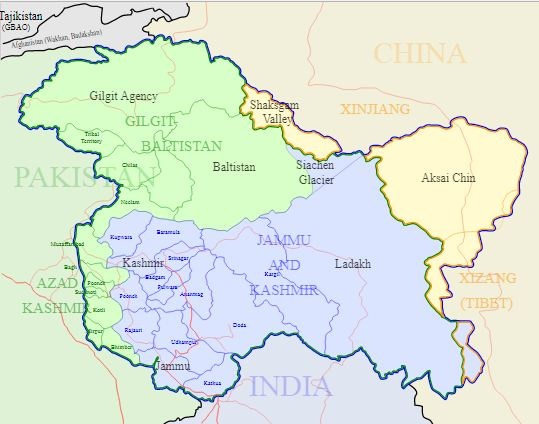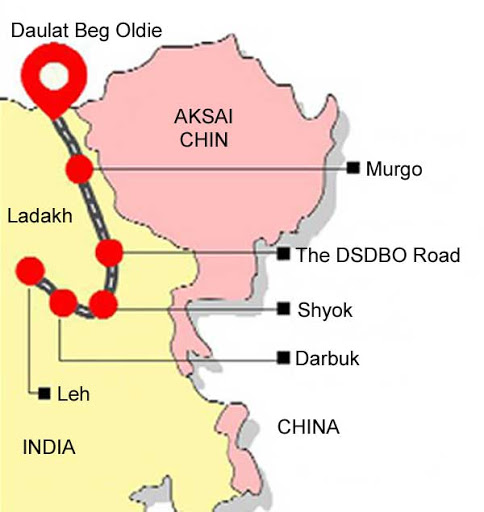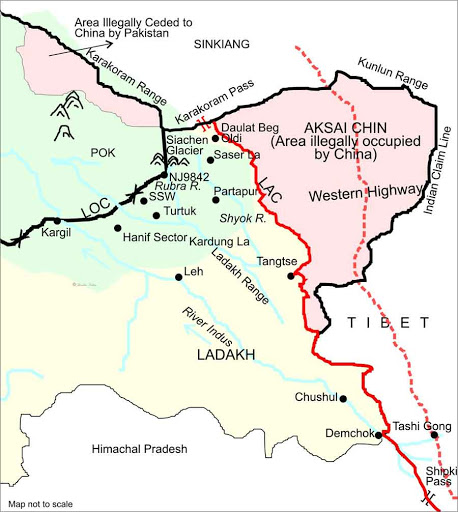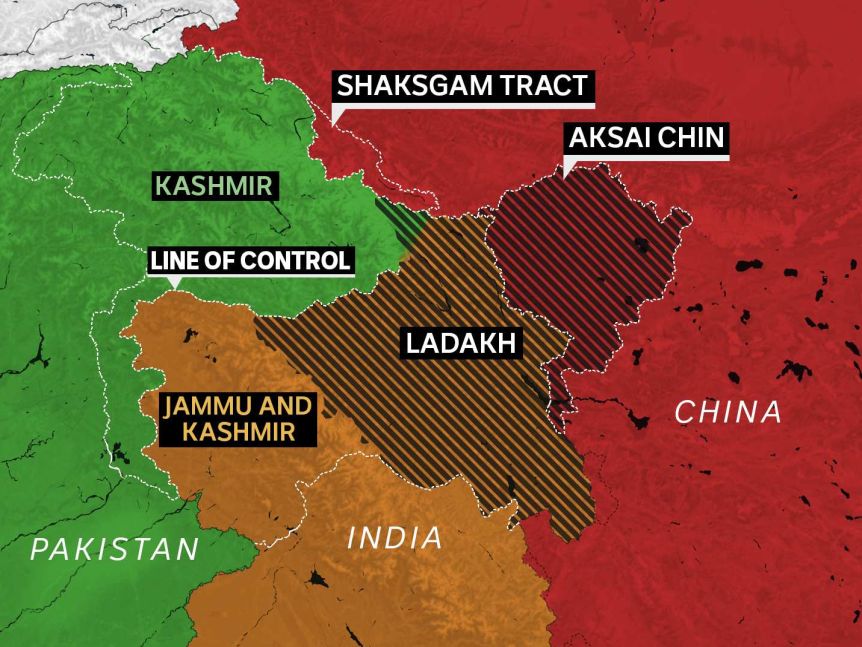Most in India think about the recent Chinese incursion into India’s Ladakh province as another isolated Chinese attempt that will cool off. To us, this goes to demonstrate the continued lack of long term strategic culture in Indian foreign policy & military. The very fact that the Indian military was surprised and caught unawares of the Chinese incursion until it was in place demonstrates that.
This harks back to the far more serious infiltration & incursion by Napaki forces into the Himalayan peaks inside India that overlook vital roads in Kashmir. That led to the military conflict in 1999 which cost the Indian military a great number of lives & taught Napaki army a very big lesson. But it should never have happened and the only reason it happened was the lack of military culture of total vigilance on the border. The current mess in Ladakh is another illustration that the culture of the Indian military is still more careless & lackadaisical than that of China.
Unlike India, China is highly determined & totally focused on its long term goal to be the hegemon of Asia. And India is in the way, not all of India but the province of Ladakh. And critical road infrastructure is the tool China has used for decades to create military advantage.
Look why we are where we are today.
1.Xinjiang-Tibet-Aksai Chin-one Road
In 1947, the advantages were all on India’s side as the British left. China was in relative tatters having gone through a destructive civil war. But China had Mao & Zhou En Lai while India had Nehru. What a disaster this match up turned out to be for India!
In 1948, the new breakout regime of NaPakistan decided to annex the state of Kashmir by sending in troops disguised as fighters from Afghanistan. After being surprised & stunned, the Indian army quickly counterattacked and took back the capital & much of the populated parts of Kashmir. The Indian military wanted to go ahead & drive the Napaki troops out of the remaining north-western section of Kashmir (green area above). But Nehru, always focused on appearing magnanimous instead of sensibly patriotic, stopped them preferring dialogue.
Thanks to that disastrously stupid decision of Nehru, the green “Gilgit-Baltistan” region in the map above remains in Napaki hands and now it is the gateway for China to reach the Arabian Sea.
One year later, in 1949, Chinese army moved into independent Xinjiang (area north of Gilgit-Baltistan) and annexed that huge province. Another year later, Chinese military moved into Tibet (to the right of Ladakh in the above map) and annexed that huge state. Now Xinjiang & Tibet are two huge buffer states that guard Chinese interior from forces that might come from the West.
But Xinjiang & Tibet remained far away from each other in reality because the yellow area titled Aksai Chin was in India’s hands. Nehru had learned nothing from China’s annexation of Xinjiang & Tibet. So he did not move the Indian Army forward into India’s “Aksai Chin” region that separated Xinjiang & Tibet.
Seeing that as an opportunity, China quietly began building a road connecting Xinjiang & western Tibet through what was Indian territory, now called Aksai Chin. India remained blissfully unaware. Then in 1957, the Chinese army moved in via the road; annexed the huge region connecting Xinjiang & Tibet and renamed it Aksai Chin. Nehru dismissed this annexation of a huge strategic part of Indian territory saying “not a blade of grass grows there“.
Understand had China immediately attacked the Aksai Chin area & tried to annex it militarily after annexing Tibet, even Nehru would have had to act militarily. Instead, China quietly & surreptitiously built a road across remote Indian territory & then, about 7 years later, send Chinese troops to occupy that barren but incredibly strategic land presenting India with a fait accompli.
Look at the map above & imagine how it would look today had Nehru allowed the Indian Army to take back the green area titled Gilgit-Baltistan and moved in Indian Army into the Aksai Chin area after China’s annexation of Tibet. That entire region would be in India’s control; China would still be barred from any land access to Napak & into the Arabian Sea and Ladakh would be totally protected today while Chinese-occupied Xinjiang would be disjoint from Chinese-occupied Tibet.
That leads us to the current conflict in Ladakh along the China-India line of control.
2. Leh-Dabruk-DBO road & Galwan feeder
Remember the Chinese strategy is to quietly build up a road infrastructure thereby building up a military advantage & then following that up with territorial claims. They have been building up their road network all along the long China-India border without any counter-buildup from India.
That began changing a few years ago & the change accelerated with PM Modi as the Prime Minister. Last year, India completed the construction of a motorable road from Leh, the capital of Ladakh to the Daulat Beg Oldi (DBO) air base located at the intersection of Napaki-held territory, India’s Ladakh & Chinese-occupied Aksai Chin. Not just any road, but, in the words of Lt. Gen Prakash Katoch, a road that
- “dominates the area where China undertook two major intrusions in April 2013 and September 2014 in the Depsang Plains, one of them 19 km deep in area of Raki Nala while Chinese premier Li Keqiang visited India.”
Then on May 9-10, India began building a feeder road from the nearby Galwan river area to this road. All this is in Indian-held territory inside the borders of India. That brings us back to the careless mentally sleepy culture of India, even its army. They thought the current borders are “settled borders” per China-India agreement.
They did not realize that nothing is ever settled with China, just as nothing was ever settled with the British in 18th century or with Afghans in 1,000-1450 CE. Hegemonic powers always plan on expansion & any development that may make a future expansion difficult is always opposed in the present by the Hegemon.
So China moved its troops into what they still claim as Chinese territory in response to what they claimed as India’s changing of the status quo. Frankly, we are really surprised how the Indian military did not move their troops to the border areas ahead of beginning the feeder road construction. Guess, the old adage that you must always expect the worst from your adversary is still not a part of the Hindu psyche.
But the question remains why China reacted in such an aggressive manner to the building of a feeder road? What long-term goals of China did that threaten down the road? Look at the map below:
Understand this is an erroneous map in that it doesn’t reflect today’s borders but reflects what they should be from Napaki point of view. That makes it helpful in understanding the longer term game.
Areas in green are NaPaki areas to their thinking. If that green area between today’s Napaki-occupied Gilgit-Baltistan & Chinese-occupied is ever captured by a joint Chinese-NaPaki military thrust from both right & left of India, then the physical handshake between China & Napak becomes large & almost impregnable. And India’s neck gets cut off & with that all access to Central Asia.
Now move down to the yellow region that mercifully Napak still describes as Indian territory. Focus on the yellow area east of the river Indus, from Leh (capital of Ladakh) to Chushul further south on the Indus river. That takes us back to 1841-1842 and the war between Dogras of Kashmir under the Sikh kingdom in India and the Tibetans under China’s Qing regime.
The Dogra-Sikhs won the battle of Leh and the control of India-Sikhs over Ladakh was ratified in the 1842 Treaty of Chushul. So today’s China could claim ownership of the entire Leh-Chushul-Demchok part of Ladakh by repudiating the 1842 treaty because Chinese Tibet was “unfairly deprived” of its territory. Now look at the macro map below, obviously a work of the China-Napak alliance.
If India makes Ladakh impregnable (which it can) and physically takes back NaPak-occupied Kashmir (in green above), then the Kashmir-Ladakh region can 1) sever the China-NaPak physical link thus cutting off China from the Arabian Sea and 2) can serve as a India’s foray into Chinese-occupied Xinjiang. Remember Xinjiang is China’s sole buffer state that protects vulnerable Chinese interior from the Muslim regions of Central Asia.
On the other hand, if China-NaPak can militarily seize Ladakh from India, the Jammu-Kashmir becomes indefensible & loss of both will be cutting off India’s neck and a total disaster for India.
So you see this conflict, even if it subsides via Chinese withdrawal from Indian territory, is not an isolated event. It is reflection of how the China-India rivalry will develop in the next 10-25 years with Napak & possibly USA.
3. China’s Strategic Assessment of India
We think it is imperative for India to understand how the Chinese perceive India’s strategic aims as well as understand how China perceives India’s strengths & weaknesses. The first step in that direction would be, in our judgement, reading the thoughtful article titled China’s Strategic Assessment of India by Yun Sun, director of the China program at the Stimson Center. We include some excerpts in this section.
Consistent with what we laid out above, Yun Sun writes,
- “China and India are both powers with regional hegemonic ambition and potential. Their structural conflict is irreconcilable until the two countries find a mutually agreeable compromise in their regional arrangements. … While the two countries have incompatible interests on a range of key issues, there’s little chance of reconciling those differences any time soon. … Despite China’s public embrace of India and the official elevation of Sino-Indian relations to an unprecedented level, Beijing’s distrust and hostility toward India run deep, and vice versa.”
Isn’t China much stronger, economically & militarily? Isn’t China’s GDP 5 times as large as India’s? But Yun Sun points out the difference between asymmetry of threat perceptions & asymmetry of national power:
- “Simply put, India sees China as its primary threat while China sees India as a secondary challenge. Beijing’s national security priorities unequivocally lie in the western Pacific. Such asymmetry of security priorities means that India may not yet rival China in national power or in a conventional or nuclear arms race, but its resolve and focus on China are significantly stronger than those of China.”
That means “China would prefer to save on costs and minimize military and strategic resources on India” and focus on the western Pacific.
There is also a change in fear of a two-front war. For several years, India has been mentally ready to fight a two-front war with NaPakistan & China. And it is also getting physically ready to do, even though it is far away from it’s desired military strength. The advantages that China-NaPak alliance had against India are now tilting in a different direction. As Yun Sen writes,
- “China’s strategic goal is to stabilize relations with India in order to avoid a two-front war with the United States and India — all while minimizing distractions.
- “For China, the prospect of facing the American military at sea and the Indian military along its southern border and in the Indian Ocean becomes much more real and dangerous with defense cooperation between the United States and India. Such cooperation will not only damage the security and stability of China’s western borderland while undermining China’s strategic influence in South Asia; it will also hinder China’s power projection capability in the Indian Ocean with the potential to threaten China’s energy supply from the Middle East. “
There is also a qualitative or soft power edge to what USA offers India.
- “China believes in power politics and its own natural superiority. Beijing’s vision for Asia is strictly hierarchical — with China at the top — and does not consider India an equal. … While India has no place in China’s vision for the regional order, the United States offers India a significant position in the Indo-Pacific Strategy.”
- “Regionally and globally, the U.S. endorsement of India’s leadership status dilutes and diminishes China’s soft power, and encourages other countries like Japan and Australia to follow suit in seeking closer ties with New Delhi. … U.S. President Donald Trump’s India policy is the biggest factor that has altered China’s calculation about India’s strategic importance and pushed Beijing to appease New Delhi.“
But there is a significant difference in how Chinese diplomats view US-India cooperation & how the Chinese Military views it. Yun Sun points out:
- “Chinese civilian observers and diplomats — former and current — have rather low expectations about India-U.S. cooperation. For them, India and the United States appear to be innately incompatible. … For these Chinese experts, the India-U.S. alignment is tactical — out of expediency — and lacks systematic commitment and binding arrangements. When conflicting calculations arise — and they will arise — the India-U.S. alignment will fall apart.”
They might prove correct very soon, if Biden & Democrats take power in November 2020. But, given the bipartisan anger towards China & the distinct possibility that Biden, even if elected, will only be a figurehead, Indo-Pacific will most probably remain a major US objective.
- “Unlike their counterparts who are more focused on diplomacy and foreign policy, Chinese defense strategists and security experts are concerned about the substance of the growing India-U.S. ties. In their view, Washington is making India offers that India cannot refuse, including but not limited to defense industry cooperation, arms sales, and information and intelligence sharing. Even if India thinks it is maintaining its autonomy, Chinese strategists see India enticed, entangled, and potentially enmeshed in institutionalized cooperative frameworks that it later cannot reject despite its aspiration for autonomy.”
How does all this impact the Indian Subcontinent?
- “The changing power equilibrium and alignment among the United States, China, India, and Pakistan have a critical impact on the crisis dynamics of South Asia. Despite the warming of ties on the surface, the suspicion and embedded hostility between China and India have in fact deepened since the introduction of the Indo-Pacific Strategy. Regional dynamics have shifted, leaving the United States and India on one side with China and Pakistan on the other.“
That has to make China feel defensive and more vulnerable. Such a China might feel compelled to lash out, if for no other reason for face & to please the PLA, as it did recently in Ladakh. But every single such lashing out just makes India get closer to the United States thus increasing China’s strategic fears. So as Yun Sun points out,
- As such, China’s policy towards India is pulled in two opposite directions — between a perhaps genuine desire for friendly ties with India so it can focus on the United States and the Pacific, and an equally genuine hostility due to conflicting agendas in Asia.”
Guess that is why they call geopolitics The Great Game!
Send your feedback to editor@macroviewpoints.com Or @MacroViewpoints on Twitter



